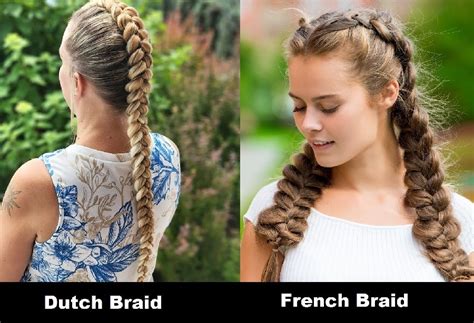Introduction
The intricate art of braiding has captivated cultures for centuries, with myriad variations emerging from different regions. Among the most popular and visually striking are Dutch and French braids, each boasting unique characteristics and applications. This comprehensive article delves into the fascinating world of these two braiding techniques, exploring their history, techniques, benefits, and applications.

Dutch Braid vs. French Braid: A Historical Perspective
Origins and Evolution:
- Dutch Braid: Originating in the Netherlands during the 1800s, the Dutch braid was initially known as the “drievlechten” (three-strand braid) and was often worn by young girls in rural areas.
- French Braid: With roots in France, the French braid first emerged in the 1600s and gained popularity among the French aristocracy. It became a symbol of elegance and sophistication.
Technical Differences: Unraveling the Intricacies
Placement:
- Dutch Braid: Woven from the top of the head, it lies flat against the scalp.
- French Braid: Starting at the nape of the neck, it wraps around the head.
Method:
- Dutch Braid: Sections are crossed over each other, with new hair added from underneath.
- French Braid: Strands are crossed over each other, with new hair added from above.
Appearance:
- Dutch Braid: Creates a raised, voluminous effect.
- French Braid: Results in a smoother, flatter look.
Benefits Galore: Why Dutch and French Braids Reign Supreme
Versatility:
- Both can be styled in a multitude of ways, from simple to elaborate.
- Suitable for various hair lengths and textures.
Protective:
- Forms a protective barrier over the hair, reducing breakage and frizz.
- Ideal for workouts or windy conditions.
Time-Saving:
- Can last for several days, eliminating the need for daily styling.
- Convenient for busy lifestyles.
Application Extravaganza: Unveiling the Endless Possibilities
Everyday Wear:
- Dutch braids: Edgy and stylish for casual outings.
- French braids: Elegant and timeless for formal events.
Sports Activities:
- Both: Secure and breathable, ideal for running, cycling, or hiking.
Special Occasions:
- Dutch braids: Intricate and eye-catching for weddings or festivals.
- French braids: Romantic and ethereal for prom or graduations.
Creative Fusion: Inventing Nouveau Braiding Techniques
Dutch Fishtail Braid: Combines the Dutch and fishtail braiding methods for a unique and eye-catching effect.
French Waterfall Braid: Creates the illusion of a waterfall cascading down the hair using French braiding techniques.
Dutch Pancake Braid: Resembles a pancake with its flat, layered appearance, combining Dutch and pancake braiding styles.
Tables of Braiding Excellence: Breaking Down the Key Differences
Table 1: Dutch vs. French Braid Placement and Technique
| Feature | Dutch Braid | French Braid |
|---|---|---|
| Placement | Top of head | Nape of neck |
| Method | Crosses sections from underneath | Crosses strands from above |
Table 2: Benefits of Dutch and French Braids
| Benefit | Dutch Braid | French Braid |
|---|---|---|
| Versatility | High | High |
| Protection | High | Moderate |
| Time-Saving | High | Moderate |
Table 3: Applications of Dutch and French Braids
| Application | Dutch Braid | French Braid |
|---|---|---|
| Everyday Wear | Casual and edgy | Formal and elegant |
| Sports Activities | Secure and breathable | Secure and stylish |
| Special Occasions | Intricate and striking | Romantic and ethereal |
Table 4: Creative Fusion Braiding Techniques
| Technique | Description |
|---|---|
| Dutch Fishtail Braid | Combines Dutch and fishtail braiding |
| French Waterfall Braid | Creates a waterfall effect using French braiding |
| Dutch Pancake Braid | Flat and layered, combining Dutch and pancake braiding |
FAQs: Unraveling the Mysteries of Dutch and French Braids
Q1: Which braid is easier to learn?
A: French braids are generally considered easier for beginners.
Q2: Can I wear a braid overnight?
A: Yes, both Dutch and French braids can last for several days.
Q3: Are braids good for hair growth?
A: Braiding can protect hair from breakage and promote healthy growth.
Q4: How do I choose the right braid for my face shape?
A: Round faces suit braids with volume, while oval faces can wear any type of braid.
Q5: Can I braid my hair myself?
A: With practice, you can master braiding techniques on your own.
Q6: What hair products are best for braiding?
A: Use products that add texture and hold, such as mousse or hairspray.
Conclusion
The enchanting world of Dutch and French braids offers a kaleidoscope of styles and applications. Understanding the technical nuances and exploring their versatility empowers you to unleash your creativity and craft braids that enhance your look and protect your hair. Whether you prefer the edgy volume of a Dutch braid or the timeless elegance of a French braid, embrace the art of braiding and let your tresses become a masterpiece of style and ingenuity.
